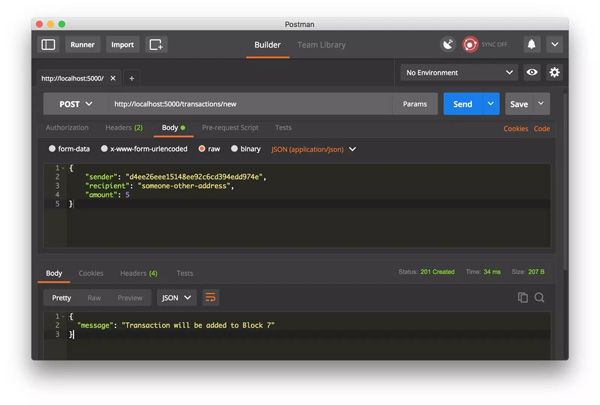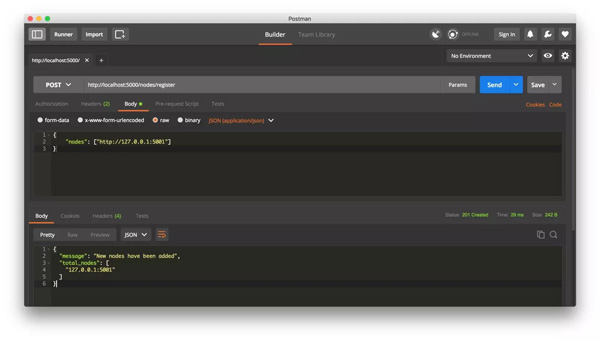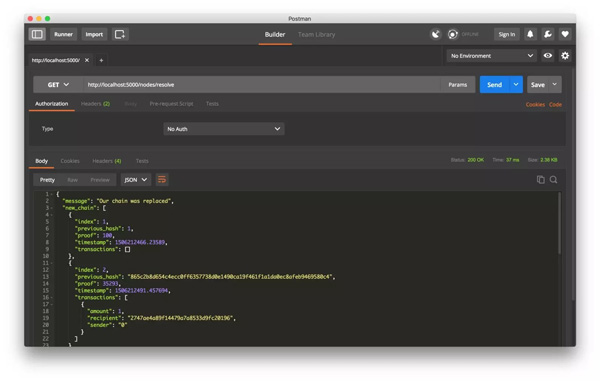作者认为最快的学习区块链的方式是自己创建一个,本文就跟随作者用Python来创建一个区块链。
对数字货币的崛起感到新奇的我们,并且想知道其背后的技术——区块链是怎样实现的。
但是完全搞懂区块链并非易事,我喜欢在实践中学习,通过写代码来学习技术会掌握得更牢固。通过构建一个区块链可以加深对区块链的理解。
准备工作
本文要求读者对Python有基本的理解,能读写基本的Python,并且需要对HTTP请求有基本的了解。
我们知道区块链是由区块的记录构成的不可变、有序的链结构,记录可以是交易、文件或任何你想要的数据,重要的是它们是通过哈希值(hashes)链接起来的。
如果你还不是很了解哈希,可以查看这篇文章
环境准备
环境准备,确保已经安装Python3.6+, pip , Flask, requests
安装方法:
- pip install Flask==0.12.2 requests==2.18.4
同时还需要一个HTTP客户端,比如Postman,cURL或其它客户端。
参考源代码(原代码在我翻译的时候,无法运行,我fork了一份,修复了其中的错误,并添加了翻译,感谢star)
开始创建Blockchain
新建一个文件 blockchain.py,本文所有的代码都写在这一个文件中,可以随时参考源代码
Blockchain类
首先创建一个Blockchain类,在构造函数中创建了两个列表,一个用于储存区块链,一个用于储存交易。
以下是Blockchain类的框架:
- class Blockchain(object):
- def __init__(self):
- self.chain = []
- self.current_transactions = []
- def new_block(self):
- # Creates a new Block and adds it to the chain
- pass
- def new_transaction(self):
- # Adds a new transaction to the list of transactions
- pass
- @staticmethod
- def hash(block):
- # Hashes a Block
- pass
- @property
- def last_block(self):
- # Returns the last Block in the chain
- pass
Blockchain类用来管理链条,它能存储交易,加入新块等,下面我们来进一步完善这些方法。
块结构
每个区块包含属性:索引(index),Unix时间戳(timestamp),交易列表(transactions),工作量证明(稍后解释)以及前一个区块的Hash值。
以下是一个区块的结构:
- block = {
- 'index': 1,
- 'timestamp': 1506057125.900785,
- 'transactions': [
- {
- 'sender': "8527147fe1f5426f9dd545de4b27ee00",
- 'recipient': "a77f5cdfa2934df3954a5c7c7da5df1f",
- 'amount': 5,
- }
- ],
- 'proof': 324984774000,
- 'previous_hash': "2cf24dba5fb0a30e26e83b2ac5b9e29e1b161e5c1fa7425e73043362938b9824"
- }
到这里,区块链的概念就清楚了,每个新的区块都包含上一个区块的Hash,这是关键的一点,它保障了区块链不可变性。如果攻击者破坏了前面的某个区块,那么后面所有区块的Hash都会变得不正确。不理解的话,慢慢消化,可参考区块链记账原理
加入交易
接下来我们需要添加一个交易,来完善下new_transaction方法
- class Blockchain(object):
- ...
- def new_transaction(self, sender, recipient, amount):
- """
- 生成新交易信息,信息将加入到下一个待挖的区块中
- :param sender: <str> Address of the Sender
- :param recipient: <str> Address of the Recipient
- :param amount: <int> Amount
- :return: <int> The index of the Block that will hold this transaction
- """
- self.current_transactions.append({
- 'sender': sender,
- 'recipient': recipient,
- 'amount': amount,
- })
- return self.last_block['index'] + 1
方法向列表中添加一个交易记录,并返回该记录将被添加到的区块(下一个待挖掘的区块)的索引,等下在用户提交交易时会有用。
创建新块
当Blockchain实例化后,我们需要构造一个创世块(没有前区块的第一个区块),并且给它加上一个工作量证明。
每个区块都需要经过工作量证明,俗称挖矿,稍后会继续讲解。
为了构造创世块,我们还需要完善newblock(), newtransaction() 和hash() 方法:
- import hashlib
- import json
- from time import time
- class Blockchain(object):
- def __init__(self):
- self.current_transactions = []
- self.chain = []
- # Create the genesis block
- self.new_block(previous_hash=1, proof=100)
- def new_block(self, proof, previous_hash=None):
- """
- 生成新块
- :param proof: <int> The proof given by the Proof of Work algorithm
- :param previous_hash: (Optional) <str> Hash of previous Block
- :return: <dict> New Block
- """
- block = {
- 'index': len(self.chain) + 1,
- 'timestamp': time(),
- 'transactions': self.current_transactions,
- 'proof': proof,
- 'previous_hash': previous_hash or self.hash(self.chain[-1]),
- }
- # Reset the current list of transactions
- self.current_transactions = []
- self.chain.append(block)
- return block
- def new_transaction(self, sender, recipient, amount):
- """
- 生成新交易信息,信息将加入到下一个待挖的区块中
- :param sender: <str> Address of the Sender
- :param recipient: <str> Address of the Recipient
- :param amount: <int> Amount
- :return: <int> The index of the Block that will hold this transaction
- """
- self.current_transactions.append({
- 'sender': sender,
- 'recipient': recipient,
- 'amount': amount,
- })
- return self.last_block['index'] + 1
- @property
- def last_block(self):
- return self.chain[-1]
- @staticmethod
- def hash(block):
- """
- 生成块的 SHA-256 hash值
- :param block: <dict> Block
- :return: <str>
- """
- # We must make sure that the Dictionary is Ordered, or we'll have inconsistent hashes
- block_string = json.dumps(block, sort_keys=True).encode()
- return hashlib.sha256(block_string).hexdigest()
通过上面的代码和注释可以对区块链有直观的了解,接下来我们看看区块是怎么挖出来的。
理解工作量证明
新的区块依赖工作量证明算法(PoW)来构造。PoW的目标是找出一个符合特定条件的数字,这个数字很难计算出来,但容易验证。这就是工作量证明的核心思想。
为了方便理解,举个例子:
假设一个整数 x 乘以另一个整数 y 的积的 Hash 值必须以 0 结尾,即 hash(x * y) = ac23dc…0。设变量 x = 5,求 y 的值?
用Python实现如下:
- from hashlib import sha256
- x = 5
- y = 0 # y未知
- while sha256(f'{x*y}'.encode()).hexdigest()[-1] != "0":
- y += 1
- print(f'The solution is y = {y}')
结果是y=21. 因为:
- hash(5 * 21) = 1253e9373e...5e3600155e860
在比特币中,使用称为Hashcash的工作量证明算法,它和上面的问题很类似。矿工们为了争夺创建区块的权利而争相计算结果。通常,计算难度与目标字符串需要满足的特定字符的数量成正比,矿工算出结果后,会获得比特币奖励。
当然,在网络上非常容易验证这个结果。
实现工作量证明
让我们来实现一个相似PoW算法,规则是:寻找一个数 p,使得它与前一个区块的 proof 拼接成的字符串的 Hash 值以 4 个零开头。
- import hashlib
- import json
- from time import time
- from uuid import uuid4
- class Blockchain(object):
- ...
- def proof_of_work(self, last_proof):
- """
- 简单的工作量证明:
- - 查找一个 p' 使得 hash(pp') 以4个0开头
- - p 是上一个块的证明, p' 是当前的证明
- :param last_proof: <int>
- :return: <int>
- """
- proof = 0
- while self.valid_proof(last_proof, proof) is False:
- proof += 1
- return proof
- @staticmethod
- def valid_proof(last_proof, proof):
- """
- 验证证明: 是否hash(last_proof, proof)以4个0开头?
- :param last_proof: <int> Previous Proof
- :param proof: <int> Current Proof
- :return: <bool> True if correct, False if not.
- """
- guess = f'{last_proof}{proof}'.encode()
- guess_hash = hashlib.sha256(guess).hexdigest()
- return guess_hash[:4] == "0000"
衡量算法复杂度的办法是修改零开头的个数。使用4个来用于演示,你会发现多一个零都会大大增加计算出结果所需的时间。
现在Blockchain类基本已经完成了,接下来使用HTTP requests来进行交互。
Blockchain作为API接口
我们将使用Python Flask框架,这是一个轻量Web应用框架,它方便将网络请求映射到 Python函数,现在我们来让Blockchain运行在基于Flask web上。
我们将创建三个接口:
- /transactions/new 创建一个交易并添加到区块
- /mine 告诉服务器去挖掘新的区块
- /chain 返回整个区块链
创建节点
我们的“Flask服务器”将扮演区块链网络中的一个节点。我们先添加一些框架代码:
- import hashlib
- import json
- from textwrap import dedent
- from time import time
- from uuid import uuid4
- from flask import Flask
- class Blockchain(object):
- ...
- # Instantiate our Node
- app = Flask(__name__)
- # Generate a globally unique address for this node
- node_identifier = str(uuid4()).replace('-', '')
- # Instantiate the Blockchain
- blockchain = Blockchain()
- @app.route('/mine', methods=['GET'])
- def mine():
- return "We'll mine a new Block"
- @app.route('/transactions/new', methods=['POST'])
- def new_transaction():
- return "We'll add a new transaction"
- @app.route('/chain', methods=['GET'])
- def full_chain():
- response = {
- 'chain': blockchain.chain,
- 'length': len(blockchain.chain),
- }
- return jsonify(response), 200
- if __name__ == '__main__':
- app.run(host='0.0.0.0', port=5000)
简单的说明一下以上代码:
第15行: 创建一个节点.
第18行: 为节点创建一个随机的名字.
第21行: 实例Blockchain类.
第24–26行: 创建/mine GET接口。
第28–30行: 创建/transactions/new POST接口,可以给接口发送交易数据.
第32–38行: 创建 /chain 接口, 返回整个区块链。
第40–41行: 服务运行在端口5000上.
发送交易
发送到节点的交易数据结构如下:
- {
- "sender": "my address",
- "recipient": "someone else's address",
- "amount": 5
- }
之前已经有添加交易的方法,基于接口来添加交易就很简单了
- import hashlib
- import json
- from textwrap import dedent
- from time import time
- from uuid import uuid4
- from flask import Flask, jsonify, request
- ...
- @app.route('/transactions/new', methods=['POST'])
- def new_transaction():
- values = request.get_json()
- # Check that the required fields are in the POST'ed data
- required = ['sender', 'recipient', 'amount']
- if not all(k in values for k in required):
- return 'Missing values', 400
- # Create a new Transaction
- index = blockchain.new_transaction(values['sender'], values['recipient'], values['amount'])
- response = {'message': f'Transaction will be added to Block {index}'}
- return jsonify(response), 201
挖矿
挖矿正是神奇所在,它很简单,做了一下三件事:
- 计算工作量证明PoW
- 通过新增一个交易授予矿工(自己)一个币
- 构造新区块并将其添加到链中
- import hashlib
- import json
- from time import time
- from uuid import uuid4
- from flask import Flask, jsonify, request
- ...
- @app.route('/mine', methods=['GET'])
- def mine():
- # We run the proof of work algorithm to get the next proof...
- last_block = blockchain.last_block
- last_proof = last_block['proof']
- proof = blockchain.proof_of_work(last_proof)
- # 给工作量证明的节点提供奖励.
- # 发送者为 "0" 表明是新挖出的币
- blockchain.new_transaction(
- sender="0",
- recipient=node_identifier,
- amount=1,
- )
- # Forge the new Block by adding it to the chain
- block = blockchain.new_block(proof)
- response = {
- 'message': "New Block Forged",
- 'index': block['index'],
- 'transactions': block['transactions'],
- 'proof': block['proof'],
- 'previous_hash': block['previous_hash'],
- }
- return jsonify(response), 200
注意交易的接收者是我们自己的服务器节点,我们做的大部分工作都只是围绕Blockchain类方法进行交互。到此,我们的区块链就算完成了,我们来实际运行下
运行区块链
你可以使用cURL 或Postman 去和API进行交互
启动server:
- $ python blockchain.py
- * Runing on http://127.0.0.1:5000/ (Press CTRL+C to quit)
让我们通过请求 http://localhost:5000/mine 来进行挖矿
用Postman请求挖矿
通过post请求,添加一个新交易
用Postman请求挖矿
如果不是使用Postman,则用一下的cURL语句也是一样的:
- $ curl -X POST -H "Content-Type: application/json" -d '{
- "sender": "d4ee26eee15148ee92c6cd394edd974e",
- "recipient": "someone-other-address",
- "amount": 5
- }' "http://localhost:5000/transactions/new"
在挖了两次矿之后,就有3个块了,通过请求 http://localhost:5000/chain 可以得到所有的块信息。
- {
- "chain": [
- {
- "index": 1,
- "previous_hash": 1,
- "proof": 100,
- "timestamp": 1506280650.770839,
- "transactions": []
- },
- {
- "index": 2,
- "previous_hash": "c099bc...bfb7",
- "proof": 35293,
- "timestamp": 1506280664.717925,
- "transactions": [
- {
- "amount": 1,
- "recipient": "8bbcb347e0634905b0cac7955bae152b",
- "sender": "0"
- }
- ]
- },
- {
- "index": 3,
- "previous_hash": "eff91a...10f2",
- "proof": 35089,
- "timestamp": 1506280666.1086972,
- "transactions": [
- {
- "amount": 1,
- "recipient": "8bbcb347e0634905b0cac7955bae152b",
- "sender": "0"
- }
- ]
- }
- ],
- "length": 3
- }
一致性(共识)
我们已经有了一个基本的区块链可以接受交易和挖矿。但是区块链系统应该是分布式的。既然是分布式的,那么我们究竟拿什么保证所有节点有同样的链呢?这就是一致性问题,我们要想在网络上有多个节点,就必须实现一个一致性的算法。
注册节点
在实现一致性算法之前,我们需要找到一种方式让一个节点知道它相邻的节点。每个节点都需要保存一份包含网络中其它节点的记录。因此让我们新增几个接口:
/nodes/register 接收URL形式的新节点列表
/nodes/resolve执行一致性算法,解决任何冲突,确保节点拥有正确的链
我们修改下Blockchain的init函数并提供一个注册节点方法:
- ...
- from urllib.parse import urlparse
- ...
- class Blockchain(object):
- def __init__(self):
- ...
- self.nodes = set()
- ...
- def register_node(self, address):
- """
- Add a new node to the list of nodes
- :param address: <str> Address of node. Eg. 'http://192.168.0.5:5000'
- :return: None
- """
- parsed_url = urlparse(address)
- self.nodes.add(parsed_url.netloc)
我们用 set 来储存节点,这是一种避免重复添加节点的简单方法。
实现共识算法
前面提到,冲突是指不同的节点拥有不同的链,为了解决这个问题,规定最长的、有效的链才是最终的链,换句话说,网络中有效最长链才是实际的链。
我们使用一下的算法,来达到网络中的共识
- ...
- import requests
- class Blockchain(object)
- ...
- def valid_chain(self, chain):
- """
- Determine if a given blockchain is valid
- :param chain: <list> A blockchain
- :return: <bool> True if valid, False if not
- """
- last_block = chain[0]
- current_index = 1
- while current_index < len(chain):
- block = chain[current_index]
- print(f'{last_block}')
- print(f'{block}')
- print("\n-----------\n")
- # Check that the hash of the block is correct
- if block['previous_hash'] != self.hash(last_block):
- return False
- # Check that the Proof of Work is correct
- if not self.valid_proof(last_block['proof'], block['proof']):
- return False
- last_block = block
- current_index += 1
- return True
- def resolve_conflicts(self):
- """
- 共识算法解决冲突
- 使用网络中最长的链.
- :return: <bool> True 如果链被取代, 否则为False
- """
- neighbours = self.nodes
- new_chain = None
- # We're only looking for chains longer than ours
- max_length = len(self.chain)
- # Grab and verify the chains from all the nodes in our network
- for node in neighbours:
- response = requests.get(f'http://{node}/chain')
- if response.status_code == 200:
- length = response.json()['length']
- chain = response.json()['chain']
- # Check if the length is longer and the chain is valid
- if length > max_length and self.valid_chain(chain):
- max_length = length
- new_chain = chain
- # Replace our chain if we discovered a new, valid chain longer than ours
- if new_chain:
- self.chain = new_chain
- return True
- return False
第一个方法 valid_chain() 用来检查是否是有效链,遍历每个块验证hash和proof.
第2个方法 resolve_conflicts() 用来解决冲突,遍历所有的邻居节点,并用上一个方法检查链的有效性, 如果发现有效更长链,就替换掉自己的链
让我们添加两个路由,一个用来注册节点,一个用来解决冲突。
- @app.route('/nodes/register', methods=['POST'])
- def register_nodes():
- values = request.get_json()
- nodes = values.get('nodes')
- if nodes is None:
- return "Error: Please supply a valid list of nodes", 400
- for node in nodes:
- blockchain.register_node(node)
- response = {
- 'message': 'New nodes have been added',
- 'total_nodes': list(blockchain.nodes),
- }
- return jsonify(response), 201
- @app.route('/nodes/resolve', methods=['GET'])
- def consensus():
- replaced = blockchain.resolve_conflicts()
- if replaced:
- response = {
- 'message': 'Our chain was replaced',
- 'new_chain': blockchain.chain
- }
- else:
- response = {
- 'message': 'Our chain is authoritative',
- 'chain': blockchain.chain
- }
- return jsonify(response), 200
你可以在不同的机器运行节点,或在一台机机开启不同的网络端口来模拟多节点的网络,这里在同一台机器开启不同的端口演示,在不同的终端运行一下命令,就启动了两个节点:http://localhost:5000 和 http://localhost:5001
- pipenv run python blockchain.py
- pipenv run python blockchain.py -p 5001
注册新节点
然后在节点2上挖两个块,确保是更长的链,然后在节点1上访问接口/nodes/resolve ,这时节点1的链会通过共识算法被节点2的链取代。
共识算法解决冲突
好啦,你可以邀请朋友们一起来测试你的区块链




































